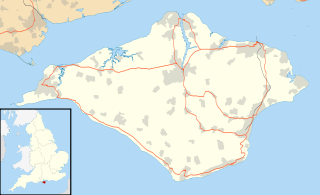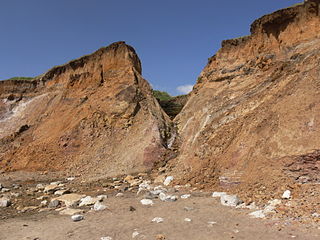
Ladder Chine is a geological feature on the south west coast of the Isle of Wight, England ( the Back of the Wight). [1] [2] It is west of the village of Chale. It is a sandy coastal ravine, one of a number of such chines on the island created by stream erosion of soft Cretaceous rocks. It leads from the 190 foot high clifftop to a knickpoint approximately halfway down the cliff face above Chale Bay beach.

The Isle of Wight is a county and the largest and second-most populous island in England. It is in the English Channel, between 2 and 5 miles off the coast of Hampshire, separated by the Solent. The island has resorts that have been holiday destinations since Victorian times, and is known for its mild climate, coastal scenery, and verdant landscape of fields, downland and chines.

England is a country that is part of the United Kingdom. It shares land borders with Wales to the west and Scotland to the north-northwest. The Irish Sea lies west of England and the Celtic Sea lies to the southwest. England is separated from continental Europe by the North Sea to the east and the English Channel to the south. The country covers five-eighths of the island of Great Britain, which lies in the North Atlantic, and includes over 100 smaller islands, such as the Isles of Scilly and the Isle of Wight.

Back of the Wight is an area on the Isle of Wight in England. The area has a distinct historical and social background and geographically isolated by the chalk hills immediately to the North and until recently, poor transport infrastructure. Primarily agricultural, the Back of the Wight is made up of small villages spread out along the coast, including Brighstone, Shorwell and Mottistone.
The Chine is the first and largest of three chines that have been eroded by a small unnamed brook that descends from Chale that drains rainwater from the west side of St. Catherine's Hill. The other two chines are Walpen Chine and New Chine. The brook initially wound its way to the cliff face and its descent over the edge created Ladder chine. As the cliff eroded, the brook found a shorter path to the sea, creating the two other chines to the east of Ladder chine. Ladder Chine is now dry.

Chale is a village and civil parish on the Isle of Wight of England, in the United Kingdom. It is located three kilometres from Niton in the south of the Island in the area known as the Back of the Wight. The village of Chale lies at the foot of St. Catherine's Down.

St. Catherine's Down is a chalk down on the Isle of Wight, located near St Catherine's Point, the southernmost point on the island. The Down rises to 240 metres at its highest point, between the towns of Niton and Chale.

Walpen Chine is a geological feature on the south west coast of the Isle of Wight, England. It is west of the village of Chale. It is a sandy coastal ravine, one of a number of such chines on the island created by stream erosion of soft Cretaceous rocks. It leads from the 190 feet high clifftop next to the Isle of Wight coastal path to a knickpoint approximately halfway down the cliff face above Chale Bay beach.
The Isle of Wight Coastal Path runs along the cliff top above this chine.

The Isle of Wight Coastal Path is a circular long-distance footpath of 70 miles (113 km) around the Isle of Wight, UK. It follows public footpaths and minor lanes, with some sections along roads.
Many Southern Vectis buses carry names that relate to coastal features around the Isle of Wight and Mini Pointer Dart 316, registered SN03LDU, carried the name Ladder Chine before being sold. Coach 590 now carries the name following repaint in Island Coaster livery for a route that operates along the Military Road, close to Ladder Chine.

Southern Vectis is a bus operator on the Isle of Wight. The company was founded in 1921 as "Dodson and Campbell" and became the "Vectis Bus Company" in 1923. The company was purchased by the Southern Railway before being nationalised in 1969. In 1987, the company was re-privatised. Southern Vectis was accused of unfair trade practices and was investigated by the British Office of Fair Trading. In July 2005, it became a subsidiary of Go-Ahead Group.



